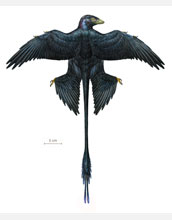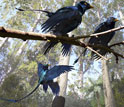News Release 12-043
Iridescent, Feathered Dinosaur: New Evidence That Feathers Evolved to Attract Mates
Earliest record of iridescent color in feathers

Reconstruction of Microraptor based on new specimen and overlays of previous specimens.
March 8, 2012
This material is available primarily for archival purposes. Telephone numbers or other contact information may be out of date; please see current contact information at media contacts.
The detailed feather pattern and color of Microraptor--a pigeon-sized, four-winged dinosaur that lived about 120 million years ago--had a glossy iridescent sheen.
Its tail was narrow and adorned with a pair of streamer feathers, suggesting the importance of display in the early evolution of feathers, say scientists reporting the findings in this week's issue of the journal Science.
By comparing the patterns of pigment-containing organelles from a Microraptor fossil to those in modern birds, the scientists determined that the dinosaur's plumage was iridescent with a glossy sheen like the feathers of a modern crow.
The new fossil is the earliest record of iridescent color in feathers.
A reconstruction of Microraptor will help scientists approach the controversy of how dinosaurs began the transition to flight.
"Specifying the color and iridescence of feathers in avian dinosaurs was not possible 20 years ago," says H. Richard Lane, program director in the National Science Foundation's (NSF) Division of Earth Sciences, which funded the research.
"This development, in combination with the arrangement of tail feathers, is leading to a deeper understanding of the early development of avian plumage signalling. "
Since it was discovered as the first four-winged dinosaur in 2003, Microraptor has been at the center of questions about the evolution of feathers and flight.
Scientists have proposed aerodynamic functions for various feathery features such as its tail, forewing shape and hind limbs.
Once thought to be a broad, teardrop-shaped surface, or with a shape more like that of a paper airplane meant to help generate lift, Microraptor's tail fan is actually much narrower with two elongate feathers off its tip.
The researchers believe the tail feathering may have been ornamental, and likely evolved for courtship and other social interactions and not as an adaptation for flight.
"Most aspects of early dinosaur feathering continue to be interpreted as fundamentally aerodynamic, optimized for some aspect of aerial locomotion," says Julia Clarke, a paper co-author and paleontologist at The University of Texas at Austin (UT-Austin).
"Some of these structures were clearly ancestral characteristics that arose for other functions and stuck around, while others may be linked to display behaviors or signaling of mate quality," she says.
Feather features were shaped by early locomotor styles, Clarke believes. "But, as any birder will tell you, feather colors and shapes may also be tied with complex behavioral repertoires and, if anything, may be costly in terms of aerodynamics."
Modern birds use feathers for many different things, ranging from flight to thermoregulation to mate-attracting displays, says Matt Shawkey, a paper co-author and biologist at the University of Akron.
"Iridescence is widespread in modern birds, and is frequently used in displays," says Shawkey. "The evidence that Microraptor was largely iridescent suggests that feathers were important for display even relatively early in their evolution."
The feather color displayed by many modern birds is partially produced by arrays of pigment-bearing organelles called melanosomes, about a hundred of which can fit across a human hair.
Generally found in a round or cigar-like shape, a melanosome's structure is constant for a given color. Iridescence arises when narrow melanosomes are organized in stacked layers.
After a breakthrough by Jakob Vinther of UT-Austin in 2009, paleontologists started analyzing the shape of melanosomes in well-preserved fossilized feather imprints.
By comparing these patterns to those in living birds, scientists can infer the color of dinosaurs that lived many millions of years ago.
Paleontologists deduced that Microraptor was iridescent when Shawkey discovered that melanosomes in the most common iridescent feathers were uniquely narrow.
Information on the feather color of a variety of dinosaurs has recently come to light.
The first color map of an extinct dinosaur showed black-and-white spangles, red coloration and grey body color in a species called Anchiornis.
Based on the new data from Microraptor and other findings, a complex color repertoire that includes iridescence is likely ancestral to a group of dinosaurs called Paraves that originated at least 140 million years ago.
It includes dinosaurs like Velociraptor as well as Archaeopteryx, Anchiornis and living birds.
"This study gives us an unprecedented glimpse of what this animal [Microraptor] looked like when it was alive," says Mark Norell, paper co-author and paleontologist at the American Museum of Natural History (AMNH).
Clarke, Norell and an AMNH team, including AMNH researchers Mick Ellison and Rui Pei, worked closely to analyze the bony anatomy and digital overlays of the feathering in the new specimen and in eight previously described Microraptor specimens.
The scientists studied feathering, and melanosome shape and density, from a Microraptor fossil.
To come to their conclusions, the researchers worked closely with Quanguo Li, Ke-Qin Gao and Meng Qingjin at the Beijing Museum of Natural History.
The samples and preservation of melanosomes were assessed by Vinther and compared to a database of melanosomes from a variety of modern birds assembled by Shawkey and Liliana D'Alba at the University of Akron.
Along with NSF, the U.S. Air Force Office of Scientific Research, the Natural Science Foundation of China, the Beijing Municipal Bureau of Human Resources, and the Beijing Academy of Science and Technology also funded the research.
-NSF-
-
Artist's rendering of Microraptor in its ancient habitat, iridescent plumage showing.
Credit and Larger Version -
Microraptor in age-old time: here, shown alone in the forest.
Credit and Larger Version -
Detail of the tips of Microraptor's well-preserved leg feathers, from beneath its tail.
Credit and Larger Version -
Microraptor's tail-feathering, showing elongate, mid-line feathers.
Credit and Larger Version -
Tail feathering in Microraptor specimens; arrows indicate feathers from the new specimen.
Credit and Larger Version -
The researchers' work is described in the March 9, 2012 issue of the journal Science.
Credit and Larger Version
Media Contacts
Cheryl Dybas, NSF, (703) 292-7734, email: cdybas@nsf.gov
Marc Airhart, University of Texas at Austin, (512) 471-2241, email: mairhart@jsg.utexas.edu
The U.S. National Science Foundation propels the nation forward by advancing fundamental research in all fields of science and engineering. NSF supports research and people by providing facilities, instruments and funding to support their ingenuity and sustain the U.S. as a global leader in research and innovation. With a fiscal year 2023 budget of $9.5 billion, NSF funds reach all 50 states through grants to nearly 2,000 colleges, universities and institutions. Each year, NSF receives more than 40,000 competitive proposals and makes about 11,000 new awards. Those awards include support for cooperative research with industry, Arctic and Antarctic research and operations, and U.S. participation in international scientific efforts.
Connect with us online
NSF website: nsf.gov
NSF News: nsf.gov/news
For News Media: nsf.gov/news/newsroom
Statistics: nsf.gov/statistics/
Awards database: nsf.gov/awardsearch/
Follow us on social
Twitter: twitter.com/NSF
Facebook: facebook.com/US.NSF
Instagram: instagram.com/nsfgov






